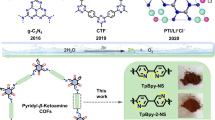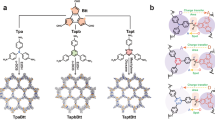Abstract
Metal–organic frameworks (MOFs) have been studied extensively in the hydrogen evolution reaction (HER) and the water oxidation reaction (WOR) with sacrificial reagents, but overall photocatalytic water splitting using MOFs has remained challenging, principally because of the fast recombination of photo-generated electrons and holes. Here we have integrated HER- and WOR-MOF nanosheets into liposomal structures for separation of the generated charges. The HER-MOF nanosheets comprise light-harvesting Zn–porphyrin and catalytic Pt–porphyrin moieties, and are functionalized with hydrophobic groups to facilitate their incorporation into the hydrophobic lipid bilayer of the liposome. The WOR-MOF flakes consist of [Ru(2,2′-bipyridine)3]2+-based photosensitizers and Ir–bipyridine catalytic centres, and are localized in the hydrophilic interior of the liposome. This liposome–MOF assembly achieves overall photocatalytic water splitting with an apparent quantum yield of (1.5 ± 1)% as a result of ultrafast electron transport from the antennae (Zn–porphyrin and [Ru(2,2′-bipyridine)3]2+) to the reaction centres (Pt–porphyrin and Ir–bipyridine) in the MOFs and efficient charge separation in the lipid bilayers.

This is a preview of subscription content, access via your institution
Access options
Access Nature and 54 other Nature Portfolio journals
Get Nature+, our best-value online-access subscription
$29.99 / 30 days
cancel any time
Subscribe to this journal
Receive 12 print issues and online access
$259.00 per year
only $21.58 per issue
Buy this article
- Purchase on Springer Link
- Instant access to full article PDF
Prices may be subject to local taxes which are calculated during checkout







Similar content being viewed by others
Data availability
Source data are provided with this paper. All of the data that support the findings of this study, including catalytic measurements, material characterizations and spectroscopic data, are available within the paper and its Supplementary Information files. Further requests about the data can be directed to the corresponding author.
References
Ciamician, G. The photochemistry of the future. Science 36, 385–394 (1912).
Barber, J. Photosynthetic energy conversion: natural and artificial. Chem. Soc. Rev. 38, 185–196 (2009).
Favereau, L. et al. A molecular tetrad that generates a high-energy charge-separated state by mimicking the photosynthetic Z-scheme. J. Am. Chem. Soc. 138, 3752–3760 (2016).
Kothe, T. et al. Combination of a photosystem 1-based photocathode and a photosystem 2-based photoanode to a Z-scheme mimic for biophotovoltaic applications. Angew. Chem. Int. Ed. 52, 14233–14236 (2013).
Tian, H., Yu, Z., Hagfeldt, A., Kloo, L. & Sun, L. Organic redox couples and organic counter electrode for efficient organic dye-sensitized solar cells. J. Am. Chem. Soc. 133, 9413–9422 (2011).
Sokol, K. P. et al. Bias-free photoelectrochemical water splitting with photosystem II on a dye-sensitized photoanode wired to hydrogenase. Nat. Energy 3, 944–951 (2018).
Li, Z. et al. Biomimetic electron transport via multiredox shuttles from photosystem II to a photoelectrochemical cell for solar water splitting. Energy Environ. Sci. 10, 765–771 (2017).
Tachibana, Y., Vayssieres, L. & Durrant, J. R. Artificial photosynthesis for solar water-splitting. Nat. Photonics 6, 511–518 (2012).
Li, F. et al. Organic dye-sensitized tandem photoelectrochemical cell for light driven total water splitting. J. Am. Chem. Soc. 137, 9153–9159 (2015).
Gurudayal et al. Perovskite–hematite tandem cells for efficient overall solar driven water splitting. Nano Lett. 15, 3833–3839 (2015).
Wang, W., Li, Z., Chen, J. & Li, C. Crucial roles of electron–proton transport relay in the photosystem II-photocatalytic hybrid system for overall water splitting. J. Phys. Chem. C 121, 2605–2612 (2017).
Cui, Y. et al. Metal–organic frameworks as platforms for functional materials. Acc. Chem. Res. 49, 483–493 (2016).
Fateeva, A. et al. A water-stable porphyrin-based metal–organic framework active for visible-light photocatalysis. Angew. Chem. Int. Ed. 51, 7440–7444 (2012).
Kalmutzki, M. J., Hanikel, N. & Yaghi, O. M. Secondary building units as the turning point in the development of the reticular chemistry of MOFs. Sci. Adv. 4, eaat9180 (2018).
Maza, W. A., Padilla, R. & Morris, A. J. Concentration dependent dimensionality of resonance energy transfer in a postsynthetically doped morphologically homologous analogue of UiO-67 MOF with a ruthenium(II) polypyridyl complex. J. Am. Chem. Soc. 137, 8161–8168 (2015).
Son, H. J. et al. Light-harvesting and ultrafast energy migration in porphyrin-based metal–organic frameworks. J. Am. Chem. Soc. 135, 862–869 (2013).
Choi, K. M. et al. Plasmon-enhanced photocatalytic CO2 conversion within metal–organic frameworks under visible light. J. Am. Chem. Soc. 139, 356–362 (2017).
Nilsson, T. et al. Lipid-mediated protein-protein interactions modulate respiration-driven ATP synthesis. Sci. Rep. 6, 24113 (2016).
Steinberg-Yfrach, G. et al. Conversion of light energy to proton potential in liposomes by artificial photosynthetic reaction centres. Nature 385, 239–241 (1997).
Li, Y. et al. Supramolecular assembly of photosystem II and adenosine triphosphate synthase in artificially designed honeycomb multilayers for photophosphorylation. ACS Nano. 12, 1455–1461 (2018).
Limburg, B. et al. Kinetics of photocatalytic water oxidation at liposomes: membrane anchoring stabilizes the photosensitizer. ACS Catal. 6, 5968–5977 (2016).
Limburg, B., Bouwman, E. & Bonnet, S. Molecular water oxidation catalysts based on transition metals and their decomposition pathways. Coord. Chem. Rev. 256, 1451–1467 (2012).
Fang, X. et al. Single Pt atoms confined into a metal–organic framework for efficient photocatalysis. Adv. Mater. 30, 1705112 (2018).
Wang, C., Wang, J.-L. & Lin, W. Elucidating molecular iridium water oxidation catalysts using metal–organic frameworks: a comprehensive structural, catalytic, spectroscopic, and kinetic study. J. Am. Chem. Soc. 134, 19895–19908 (2012).
Hu, Z. et al. Kinetically controlled synthesis of two-dimensional Zr/Hf metal–organic framework nanosheets via a modulated hydrothermal approach. J. Mater. Chem. A 5, 8954–8963 (2017).
Maza, W. A. & Morris, A. J. Photophysical characterization of a ruthenium(II) tris(2,2′-bipyridine)-doped zirconium UiO-67 metal–organic framework. J. Phys. Chem. C 118, 8803–8817 (2014).
Feng, D. et al. Zirconium-metalloporphyrin PCN-222: mesoporous metal–organic frameworks with ultrahigh stability as biomimetic catalysts. Angew. Chem. Int. Ed. 51, 10307–10310 (2012).
He, T. et al. Ultrathin 2D zirconium metal–organic framework nanosheets: preparation and application in photocatalysis. Small 14, 1703929 (2018).
Dai, R. et al. Electron crystallography reveals atomic structures of metal–organic nanoplates with M12(μ3-O)8(μ3-OH)8(μ2-OH)6 (M = Zr, Hf) secondary building units. Inorg. Chem. 56, 8128–8134 (2017).
Cliffe, M. J. et al. Metal–organic nanosheets formed via defect-mediated transformation of a hafnium metal–organic framework. J. Am. Chem. Soc. 139, 5397–5404 (2017).
Xie, R., Hong, S., Feng, L., Rong, J. & Chen, X. Cell-selective metabolic glycan labeling based on ligand-targeted liposomes. J. Am. Chem. Soc. 134, 9914–9917 (2012).
Wang, C., deKrafft, K. E. & Lin, W. Pt nanoparticles@photoactive metal–organic frameworks: efficient hydrogen evolution via synergistic photoexcitation and electron injection. J. Am. Chem. Soc. 134, 7211–7214 (2012).
Lv, H. et al. A noble-metal-free, tetra-nickel polyoxotungstate catalyst for efficient photocatalytic hydrogen evolution. J. Am. Chem. Soc. 136, 14015–14018 (2014).
Kim, D., Whang, D. R. & Park, S. Y. Self-healing of molecular catalyst and photosensitizer on metal–organic framework: robust molecular system for photocatalytic H2 evolution from water. J. Am. Chem. Soc. 138, 8698–8701 (2016).
Zhang, F.-M. et al. Rational design of MOF/COF hybrid materials for photocatalytic H2 evolution in the presence of sacrificial electron donors. Angew. Chem. Int. Ed. 57, 12106–12110 (2018).
Eckenhoff, W. T. & Eisenberg, R. Molecular systems for light driven hydrogen production. Dalton Trans. 41, 13004–13021 (2012).
Bae, E. & Choi, W. Effect of the anchoring group (carboxylate vs phosphonate) in Ru-complex-sensitized TiO2 on hydrogen production under visible light. J. Phys. Chem. B 110, 14792–14799 (2006).
Lan, Q. et al. Highly dispersed polyoxometalate-doped porous Co3O4 water oxidation photocatalysts derived from POM@MOF crystalline materials. Chem. Eur. J. 22, 15513–15520 (2016).
Huang, Z. et al. Efficient light-driven carbon-free cobalt-based molecular catalyst for water oxidation. J. Am. Chem. Soc. 133, 2068–2071 (2011).
Chi, L., Xu, Q., Liang, X., Wang, J. & Su, X. Iron-based metal–organic frameworks as catalysts for visible light-driven water oxidation. Small 12, 1351–1358 (2016).
Wang, Q. et al. Particulate photocatalyst sheets based on carbon conductor layer for efficient Z-scheme pure-water splitting at ambient pressure. J. Am. Chem. Soc. 139, 1675–1683 (2017).
Iwase, A., Ng, Y. H., Ishiguro, Y., Kudo, A. & Amal, R. Reduced graphene oxide as a solid-state electron mediator in Z-scheme photocatalytic water splitting under visible light. J. Am. Chem. Soc. 133, 11054–11057 (2011).
Melo, M. A. et al. Surface photovoltage measurements on a particle tandem photocatalyst for overall water splitting. Nano Lett. 18, 805–810 (2018).
Zhu, M., Sun, Z., Fujitsuka, M. & Majima, T. Z-scheme photocatalytic water splitting on a 2D heterostructure of black phosphorus/bismuth vanadate using visible light. Angew. Chem. Int. Ed. 57, 2160–2164 (2018).
Gurzadyan, G. G., Tran-Thi, T.-H. & Gustavsson, T. Time-resolved fluorescence spectroscopy of high-lying electronic states of Zn-tetraphenylporphyrin. J. Chem. Phys. 108, 385–388 (1998).
Tran Thi, T. H., Desforge, C., Thiec, C. & Gaspard, S. Singlet–singlet and triplet–triplet intramolecular transfer processes in a covalently linked porphyrin–phthalocyanine heterodimer. J. Phys. Chem. 93, 1226–1233 (1989).
Reichardt, C. et al. Excited state dynamics of a photobiologically active Ru(II) dyad are altered in biologically relevant environments. J. Phys. Chem. A 121, 5635–5644 (2017).
Limburg, B., Bouwman, E. & Bonnet, S. Rate and stability of photocatalytic water oxidation using [Ru(bpy)3]2+ as photosensitizer. ACS Catal. 6, 5273–5284 (2016).
Wang, C., Xie, Z., deKrafft, K. E. & Lin, W. Light-harvesting cross-linked polymers for efficient heterogeneous photocatalysis. ACS Appl. Mater. Interfaces 4, 2288–2294 (2012).
Hong, D., Yamada, Y., Nagatomi, T., Takai, Y. & Fukuzumi, S. Catalysis of nickel ferrite for photocatalytic water oxidation using [Ru(bpy)3]2+ and S2O82−. J. Am. Chem. Soc. 134, 19572–19575 (2012).
Jiang, Y. et al. Simulating powder X-ray diffraction patterns of two-dimensional materials. Inorg. Chem. 57, 15123–15132 (2018).
Hatchard, C. G. & Parker, C. A. A new sensitive chemical actinometer - II. Potassium ferrioxalate as a standard chemical actinometer. Proc. R. Soc. Lond. A 235, 518–536 (1956).
Acknowledgements
We acknowledge funding support from the Ministry of Science and Technology of China (2016YFA0200702) and the National Natural Science Foundation of China (no. 21671162 and no. 21721001). We acknowledge R. Huang and S. Zhang, B. Xu, Q. Wang, D. Guo and Y. Jiang for experimental help.
Author information
Authors and Affiliations
Contributions
H.H. and C.W. conceived and designed this project. H.H. carried out the synthesis of the materials, characterized the materials and analysed the data. L.C. helped with the data analysis and structural determination. H.H. also performed the catalysis study. Z.W. and C.Z. performed the transient absorption experiments and data analysis. L.Z. performed elemental analysis. H.H., C.W. and W.L. wrote the manuscript. All the authors discussed the results and commented on the manuscript.
Corresponding author
Ethics declarations
Competing interests
The authors declare no competing interests.
Additional information
Publisher’s note Springer Nature remains neutral with regard to jurisdictional claims in published maps and institutional affiliations.
Supplementary information
Supplementary Information
Supplementary Figures 1–67, Tables 1–12, general experimental and chemicals, methods and refs. 1–21.
Source data
Source Data Fig. 2
AFM height measurement.
Source Data Fig. 3
Spectroscopic source data.
Source Data Fig. 4
Statistical source data.
Source Data Fig. 5
Spectroscopic source data.
Rights and permissions
About this article
Cite this article
Hu, H., Wang, Z., Cao, L. et al. Metal–organic frameworks embedded in a liposome facilitate overall photocatalytic water splitting. Nat. Chem. 13, 358–366 (2021). https://doi.org/10.1038/s41557-020-00635-5
Received:
Accepted:
Published:
Issue Date:
DOI: https://doi.org/10.1038/s41557-020-00635-5
This article is cited by
-
Analysis of metal–organic framework-based photosynthetic CO2 reduction
Nature Synthesis (2024)
-
Bimetallic Complexes: Fluorescence Performances and Loaded with Gel-Chinese Herb “Duhuo Jisheng Decoction” on Knee Osteoarthritis Rats
Journal of Inorganic and Organometallic Polymers and Materials (2024)
-
Solar-assisted photocatalytic water splitting using defective UiO-66 solids from modulated synthesis
Nano Research (2024)
-
Accelerating Oxygen Electrocatalysis Kinetics on Metal–Organic Frameworks via Bond Length Optimization
Nano-Micro Letters (2024)
-
Tailoring the surface and interface structures of photocatalysts to enhance hydrogen production
Science China Chemistry (2024)



